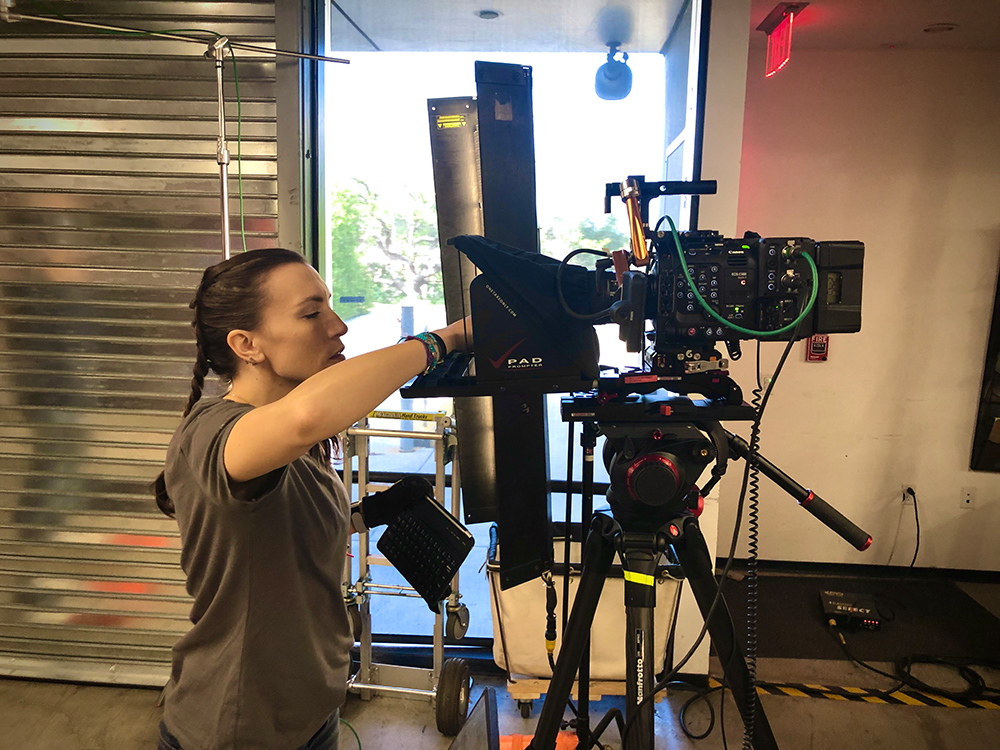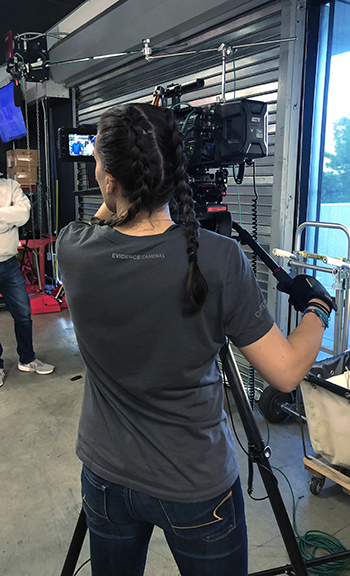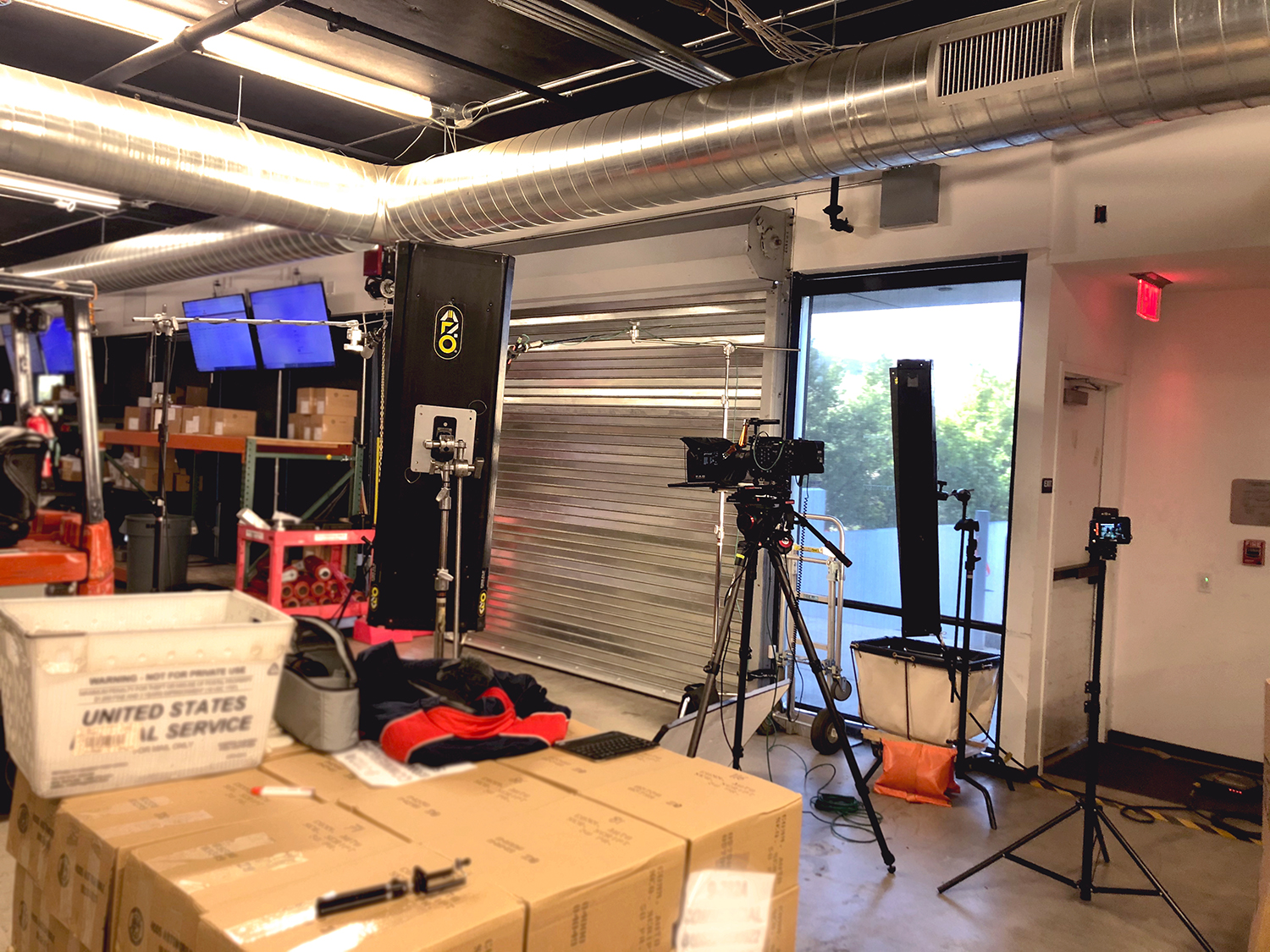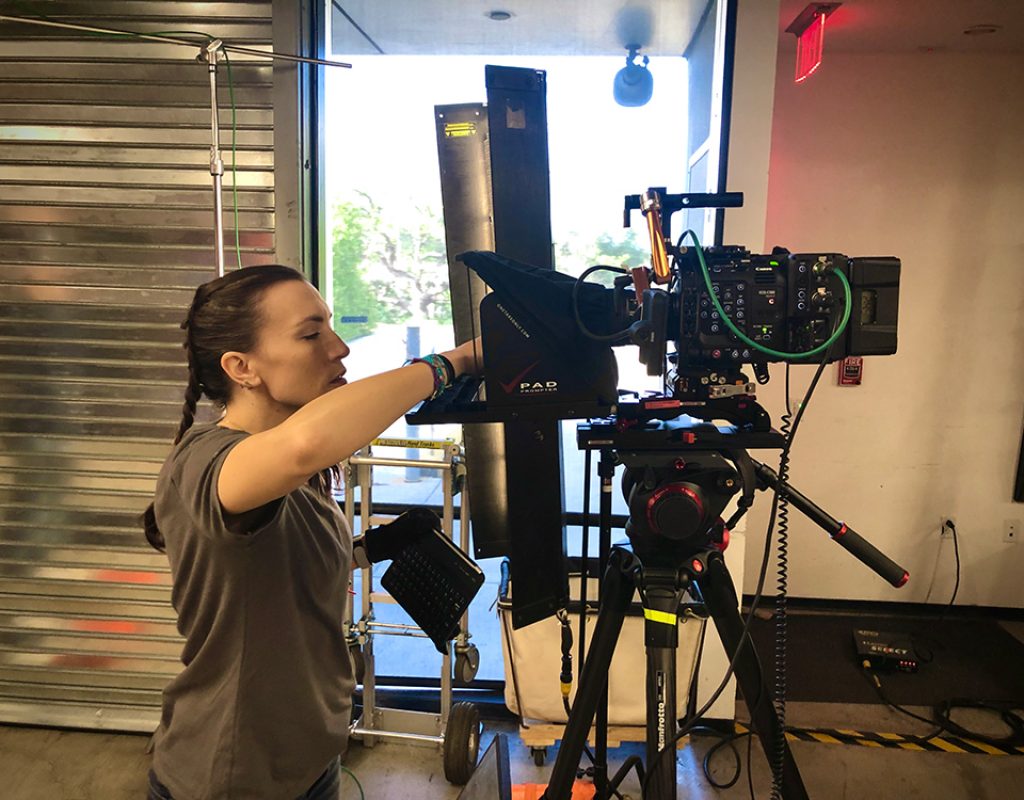 It was just a month ago, at the end of February, that I took stock of how well things had been going for the small production company that I co-own, which is based in Los Angeles, California. The addition of the Canon C500mkII to our gear list had certainly been a highlight as we created new content. My team and I had just gotten back from a shoot in Vegas, and the client was so happy they were already inquiring about when we could squeeze them in for another shoot, given our already busy March shooting schedule. Things were bustling, bookings were coming in for April, and we even had one as far out as July.
It was just a month ago, at the end of February, that I took stock of how well things had been going for the small production company that I co-own, which is based in Los Angeles, California. The addition of the Canon C500mkII to our gear list had certainly been a highlight as we created new content. My team and I had just gotten back from a shoot in Vegas, and the client was so happy they were already inquiring about when we could squeeze them in for another shoot, given our already busy March shooting schedule. Things were bustling, bookings were coming in for April, and we even had one as far out as July.
Then the world changed.
What happened over the next month was cancellation after cancellation of narrative shoots, industrial shoots, and even charity events that I stage manage. One of my many jobs includes shooting for the Los Angeles County of Education (LACOE), and I watched things shift from the ordinary to extraordinary as COVID-19 spread faster than the informative scripts going out to the public could be generated. My coworkers, with whom I had often shared a handshake or high-five, were keeping their distance, despite touching the same equipment and camera gear throughout the studio. It wasn’t fear per se, but it was readily apparent that none of us felt well-informed or prepared.
It was apparent that film shoots and productions were already in flux, and it didn’t take long for my colleagues and I to see work canceled as far out as August of 2020. While the ‘safer at home’ order still lists media as essential work, my co-workers and friends still lost vital sources of income as sets closed down, productions halted, and the rest of the world slowed to a standstill.
The impact on creative professionals
I find myself in a bracket of fellow artist who, whether union workers or freelancers, have learned to navigate the ebb and flow of production, so we budget and save accordingly. We work in a business that can be booming one month and then quiet and slow the next. The only thing consistent about content creation is the inconstant. But many of us had jobs lined up through the summer and so were opting to pay down debt and credit cards instead of saving more for a rainy day. Like much of the world, we were caught unprepared for a total and instantaneous need to stop and isolate.
Like so many people in this pandemic, I‘ve been draining my savings on account of the limited work options. Without work, I found it very easy to self-isolate, even before it became an official order. In the last month, I’ve only been to Costco, Ralph’s, Smart and Final, and the post office. No one has been to my apartment/office since March 11th, and I have been strictly following all social distancing guidelines.
That’s why I was hesitant about returning the call from a producer I’ve worked with on multiple occasions when he left me a voicemail at 9pm regarding an urgent one-day shoot. Why would this shoot need to happen now, and what would others think of me taking such work?
Non-negotiables of production while maintaining social distance
 Earlier that day, I had been on the phone with another project manager who was catching me up on their now non-existent shooting schedule. Not only are they not shooting anything at all in-studio or on location, but they’re having to teach the face figures of the company how to shoot videos on their smartphones so that the pertinent information gets out—without having to send out a camera crew and jeopardize the health and wellbeing of anyone in front of or behind the camera. That, however, is exactly what the job that I was now being asked to film was doing: it was putting all involved at risk by working during the quarantine to shoot (what I would later find out) was a video to furlough hundreds of workers.
Earlier that day, I had been on the phone with another project manager who was catching me up on their now non-existent shooting schedule. Not only are they not shooting anything at all in-studio or on location, but they’re having to teach the face figures of the company how to shoot videos on their smartphones so that the pertinent information gets out—without having to send out a camera crew and jeopardize the health and wellbeing of anyone in front of or behind the camera. That, however, is exactly what the job that I was now being asked to film was doing: it was putting all involved at risk by working during the quarantine to shoot (what I would later find out) was a video to furlough hundreds of workers.
I felt torn about my decision to take the job at hand. Had I not known the producer personally, I probably would’ve just passed, but, ultimately, this felt like the type of shoot where pertinent information had to be captured in a professional way so that everyone would get it clearly and concisely without distraction. So, I made a list of non-negotiables that would have to happen for me to maintain social distance while filming.
This is what I came up with:
- The studio location had to be completely vacant for at least one week, but preferably two.
- No crew. I would enter the space and set up video, audio, and lighting equipment and load it all out at the end by myself.
- All individuals on set had to be practicing self-isolation for two weeks prior to the shoot
- The number of necessary people on set would be kept to a minimum, and we would observe social distancing of 6 feet for all involved
- This also meant no makeup
- Absolutely NO lavaliere microphones.
- I had to see the script before I agreed to anything
As I awaited the script and availability from the owners of a studio location for the shoot date, I had time to chat with some friends, one of whom is a successful DP with multiple studio shoots that have all been put on hold. We discussed the ways in which crew could change standard operations so that work and social distancing could coexist; after all, when it comes to studio work, there are very concrete union standards about who can touch what on set. We discussed Gloria Calderón Kellett’s tweet, which led to the suggestion of a “drama camp” type of production environment where everyone is tested and quarantined before and after filming on location; could that work?
The bottom line that we kept circling back to, though, was that production is interactive— it is collaborative: we create within shared set spaces, talk between takes over open snack bowls at craft services, and inevitably cram lots of bodies into small locations. Even if you could isolate every single department, you would always have talent, hair/makeup artists, costumers, and prop masters who were at risk for infection and transmission. And if one member of the cast and crew becomes infected, then all of a sudden you no longer have a productive production camp; now you just have a liability and insurance nightmare.
But the job on the table waiting for my answer wasn’t an ongoing production; it was less than a half-day shoot, with 4 or 5 people involved. Ultimately, every content creator whom I spoke with said that if given the opportunity, they would take the job. We came to the general consensus that the stimulus package coming out of D.C. wouldn’t be here on Wednesday when rent is due, and even if it arrived sooner than later in California, a one-time $1200 check isn’t going to go very far. So I started prepping for the shoot.
Problems, pandemics and pre production
Issues that wouldn’t normally be problematic quickly started to present themselves: I still hadn’t seen a script, I was unable to secure a studio location that I personally knew or trusted the cleanliness of, and we were going to need to rent more gear than I would’ve initially liked –including a teleprompter and a second boom mic. Remember, no lavs and no crew means that in order to get the best audio that I could, I would need a boom over each person on camera, and the newest update was that both company heads may want to be in the video together.
Additionally, the producer wanted me to hire the AC with whom we normally work, both because she owns an additional Sennheiser MKH50 mic, and because she’s a workhorse who’s an absolute joy to be around. However, I felt a personal responsibility for any additional crew: if she caught the virus, I would know that she got it because of my decision to do the shoot. I brought that concern to her and let her make the decision. She had personally been self-isolating for weeks, and, of course, she was all in. Next, I was able to secure the teleprompter rental through ShareGrid, and honestly, it was easier than I had expected. I especially appreciate that the guy whom I rented it from placed the case on the sidewalk and stepped back to allow us both to maintain distance between us.
As for the location, we were hitting roadblock after roadblock. About 36 hours out from the shoot, the producer offered up his personal home to film, which didn’t feel right to me. I didn’t want to transmit the virus to someone if I did happen to be asymptomatic by going into his personal home, anymore than I would want to catch the virus and bring it home with me. Luckily, what did fall into place was the option of using one of the warehouse locations that the company being filmed owned. It had been shut down for weeks and would be empty for the shoot.
Fourteen hours before our call time, I had gotten the script into the teleprompter and felt like I had made the right choice. The work that lay ahead of me wasn’t frivolous or irresponsible. I felt no different than essential media personnel reporting for duty, set to make a little money for both myself and my AC, all while still practicing social distancing and good hygiene.
What actually happened wasn’t as “safe” as I would’ve liked, and I don’t even know if stringently sticking to my non-negotiable list would’ve made it any more so.
 The best-laid plans of producers and DPs…
The best-laid plans of producers and DPs…
I loaded my car 12 hours before call time with essential gear on the left of the truck (gear that would definitely enter into the warehouse location: tripod, 5 c-stands, 5 sandbags, 2 4×4 Kino Banks/Ballasts, boom pole, 1 solid flag, and 1 surf board) and potential gear that I could see needing on the day but would leave in the vehicle unless I actually need it so as to minimize unnecessary contamination (including: additional c-stands and sandbags, 2 directors chairs, duvetyn, additional battery operated lights including 2 Aputure MCs, a pizza box and 5-in1 collapsible reflector/diffusion). The gear didn’t touch, so as not to cross-contaminate. I then set up the C500mkII with two audio input channels and a 24-105mm lens, and I configured a Teradek bolt with a Smallhd monitor. I left as much of the camera package completely set up as I could, again doing everything possible to minimize contaminating cases and gear when on set.
I admit, I didn’t sleep well the night before the shoot. I was restless and antsy and worried about if I had packed the right gear for the job; going in blind to a location isn’t new to me – but going in blind while limiting what G&E package I bring with me is. I didn’t even know if the location had windows or what types of bulbs were in the warehouse. When I got up to get ready for set, I braided my hair back away from my face— a deliberate choice to avoid touching my hair because of loose fly aways, and to limit the temptation to adjust or touch a hat on my head. I put my two cups of coffee in a travel mug, but I didn’t bring along my standard reusable water bottle— instead I opted for a disposable bottle of vitamin water. It felt a little like preparing for one of those post-apocalyptic movies where you have to strategically dress, and everything that you choose to carry must have a valuable purpose, or it gets left behind.
Arriving at the location was so surreal. At 9 o’clock Saturday morning, March 28th, 2020, the 101 North wasn’t a bustling Los Angeles freeway. The producer greeted me with great reticence— unusual for him because he’s a hugger whom I’ve known for over 4 years and whom I have logged many hours on sets with. He said, “I’d ask what I can carry, but I know that you won’t let me,” remembering, at least momentarily, that part of the agreement of using the warehouse space was that I would be the only one to touch gear for everyone’s safety.
To my relief, the two men who owned the company were taking the pandemic, and all warnings that go along with social distancing, very seriously. There was hand sanitizer in the lobby and informative signage about the virus throughout the building and in the bathrooms. I threw on my work gloves and got to work. Thankfully, the light in the location was easily controllable, the Kinos I’d brought were more than adequate with a little bounce from the silver side of the surfboard, and I wouldn’t need any of the additional lights that I brought.
Unfortunately, once my AC arrived, my ability to enforce my rule of being the sole crew member to touch any gear dissipated. By the third trip to my vehicle, all three of us were carrying things – not for any other reason than I didn’t have the willpower to keep telling them, “no, I’ve got it. No, please don’t touch. No I’ll do it.”
A new normal
I think the thing that we easily forget and take for granted is that just as we filmmakers form a sort of second family with our team, we also form habits for the various types of productions that we’re on. Especially when working on smaller or non-union productions, where everyone wears multiple hats, we’re used to working together for the good of the team— carrying gear that may not be for our department, in an overwhelming desire to just get the job done (and sometimes get it done fast so that we can move on or wrap early). The way that we work becomes habitual – I know my work on an industrial will have different crew and equipment than my work doing narrative content. The way that I have habitually been working for years with my teams is a subconscious workload that, at this point, has to be relearned if social distancing becomes the new standard in the workplace for the foreseeable future.
We all know that where there’s a monitor, there’s going to be heads huddled around it. The first thing that inevitably happened when picture was up was crowding around the camera because that’s where I was. I reminded both the producer and the AC that we weren’t at six-feet distance and pointed at the wireless monitor system that I had set up— six feet back— for my producer to return to. I am an assertive person, and I know my place depending on the various roles that I’m hired for on set; despite my familiarity with this producer, I admittedly had a moment of hesitation when I told him to step back. This is not a normal behavior for me, neither as a person nor in the production hierarchy, but it is what those who are better informed than I am have told me that I need to do to in order to be responsible and not transmit the virus during this pandemic.
And then there’s my AC. She and I are always whispering in each other’s ear, constantly checking in, but we couldn’t do that for this shoot. What did happen was that both of us kept stepping in much closer to one another than six feet. At one point, she grabbed the keyboard and brought it over to me the moment we realized that the script on the teleprompter needed some adjusting – she’s always looking ahead to get a jumpstart on what I need next – and then she chastised herself the moment she handed it to me, as she realized, “ugh… I shouldn’t have touched that.”
At the end of a shoot, I didn’t have the energy to keep insisting about social distancing. Both men had done a great job for their first time using a teleprompter, but between the learning curve and the differences in opinion of how the video should look, the shoot ran long. Yes, even talent was (thankfully) insistent on keeping the six-feet distance between them, which meant that they were in a wide two-shot; it didn’t feel personable enough given the content, so instead of a single wide shot, we ended up filming individual close-ups as well. Since I owned all of the equipment (minus a couple pieces that I rented), I allowed them to carry out equipment for the sake of expediency; after all, we had all washed our hands at various points and used the hand sanitizers that were all around the warehouse, and my AC and I still had on our work gloves. No hands were shaken and no hugs given, but while I was loading my car, the remaining three remaining people slowly but surely got closer and closer together – out of human nature or an attempt to hear one another better, I don’t know, but the mandated distance between us all was nearly forgotten by that point in time, despite the absolute best of intentions.
When I got home, I unloaded all of the gear while wearing gloves, and I sanitized cases and equipment that needed to go inside of my apartment. All other gear was placed in the garage and will remain there, untouched, for 14 days, since some of the gear contains stainless steel and glass, which apparently the virus can survive on longer than on other materials. I disinfected my shoes and left them by the door to dry, placed all clothing in the laundry, removed my braids, and took a long shower. My mind wandered to the science-fiction stories that I loved to read and watch, where the individual who ventured outside would have to go through extensive steps to clean her/his body and gear to protect her/himself and others from whatever toxic element was part of daily life. Even when I returned the rented teleprompter, which I had already disinfected, it was still received by a person wearing gloves and a mask.
The value of production
Now that I’ve delivered the final video to the company, the gravity of the situation has hit me full force. I broke the “shelter in place” order to help give two men (who obviously care so greatly about their employees) the chance to tell them as “in-person” as they possibly could that they no longer have work to report for. I’ve done corporate and industrial videos before, but I’ve never had as much of a personal investment as I have developed with this one. With the project delivered, I can sense for the first time why shooting this video was so important. I recognize the value that a produced video has, as well as the impact that it will leave when these kinds of tough messages must be delivered.
My heart goes out to all of the employees in the world who are being furloughed or laid off completely. My heart goes out to all of the freelancers and artists who have no idea when their next gig may come in, and may, like me, face an ethical dilemma when it does. But I am now more resolute than ever, with the knowledge that if I can help minimize the sacrifices of hospital workers, first responders, and grocery clerks by limiting the number of times that I leave my house and cut off the transmission of this virus, then that is my full-time job at this moment, and the rest will have to be handled as it comes.
If you do go out and shoot, remember that while filmmaking is a beautiful and collaborative process, now, more than ever, is not the time to share gear, or work with a team, even if you all have been isolating. Even if you have all of the gear that you need and you can set up and tear down alone, I will tell you from firsthand experience, social distancing will still be difficult—not necessarily with the on-camera talent, but with the producer and/or director who will (out of habit) want to peer over your shoulder and look at the frame, and with others on set who will see you carrying heavy gear and want to help.
Whatever you do, be safe out there.

Filmtools
Filmmakers go-to destination for pre-production, production & post production equipment!
Shop Now













